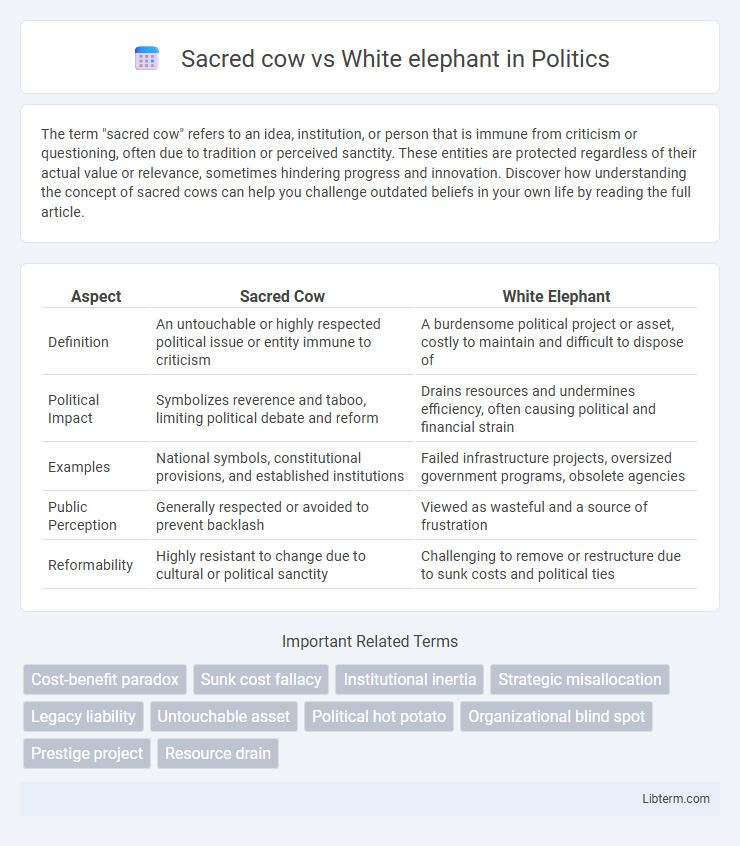The term "sacred cow" refers to an idea, institution, or person that is immune from criticism or questioning, often due to tradition or perceived sanctity. These entities are protected regardless of their actual value or relevance, sometimes hindering progress and innovation. Discover how understanding the concept of sacred cows can help you challenge outdated beliefs in your own life by reading the full article.
Table of Comparison
| Aspect | Sacred Cow | White Elephant |
|---|---|---|
| Definition | An untouchable or highly respected political issue or entity immune to criticism | A burdensome political project or asset, costly to maintain and difficult to dispose of |
| Political Impact | Symbolizes reverence and taboo, limiting political debate and reform | Drains resources and undermines efficiency, often causing political and financial strain |
| Examples | National symbols, constitutional provisions, and established institutions | Failed infrastructure projects, oversized government programs, obsolete agencies |
| Public Perception | Generally respected or avoided to prevent backlash | Viewed as wasteful and a source of frustration |
| Reformability | Highly resistant to change due to cultural or political sanctity | Challenging to remove or restructure due to sunk costs and political ties |
Introduction to Sacred Cow and White Elephant
Sacred cows are revered animals in Hindu culture, symbolizing non-violence and respect, often protected from harm or consumption. White elephants, historically considered rare and auspicious in Southeast Asian traditions, symbolize power and prosperity and are traditionally kept as royal possessions. Both terms have evolved metaphorically to describe concepts or entities that are highly valued but may become burdensome.
Historical Origins of "Sacred Cow
The term "Sacred Cow" originates from ancient Hindu traditions in India, where cows were revered and protected due to their association with the goddess Kamadhenu and their vital role in agrarian society. This cultural reverence elevated cows to a status beyond economic utility, symbolizing purity and non-violence, which has influenced the phrase's metaphorical use to describe something immune to criticism or questioning. In contrast, "White Elephant" traces back to a historical context in Southeast Asia, where rare albino elephants were considered sacred but costly burdens, symbolizing possessions that are valuable yet difficult to maintain.
Evolution of the "White Elephant" Term
The term "White Elephant" evolved from the rare albino elephants in Southeast Asia, considered sacred and costly to maintain, often given as a burdensome gift to indebted nobles. Over time, the phrase came to symbolize an expensive possession that is more trouble than it is worth, contrasting with the "Sacred Cow," which denotes an untouchable or revered entity immune from criticism. This semantic shift highlights cultural perceptions of value, burden, and sanctity embedded in these symbolic animals.
Core Differences Between Sacred Cow and White Elephant
A sacred cow is an entity or idea regarded as beyond criticism, often due to cultural, religious, or institutional reverence, while a white elephant refers to a possession or project that is costly, burdensome, and difficult to maintain without practical value. Sacred cows symbolize untouchable traditions or beliefs, whereas white elephants represent impractical investments draining resources. The core difference lies in reverence versus liability: sacred cows are protected from change, whereas white elephants are burdensome assets often sought to be discarded.
Cultural Significance in Modern Society
The sacred cow symbolizes deep cultural reverence and protection in Hindu society, representing purity and non-violence, which continues to influence contemporary ethical and religious practices. The white elephant, esteemed in Southeast Asian cultures such as Thailand and Myanmar, signifies royal power, prosperity, and spiritual significance, often central to rituals and political symbolism. Both entities reflect enduring cultural values that shape social norms, traditions, and identity in modern societies across Asia.
Economic Implications of Sacred Cows and White Elephants
Sacred cows often represent protected assets or practices in an organization that resist change despite inefficiencies, leading to resource misallocation and reduced economic productivity. White elephants, conversely, are costly projects or investments that provide little to no economic return, burdening budgets with maintenance expenses and opportunity costs. Both concepts underscore the necessity for critical evaluation to prevent financial drain and promote efficient allocation of capital and labor in economic systems.
Examples in Politics and Organizations
In politics, a sacred cow often refers to policies like Social Security in the United States, which remains untouchable despite calls for reform due to its symbolic and practical importance. White elephants appear in organizations as costly projects like abandoned infrastructure or obsolete technology, such as the US military's F-35 fighter jet program, criticized for excessive expenses with limited utility. Both terms highlight challenges in managing resources and the reluctance to change entrenched systems within political and organizational contexts.
Societal Impact of Preserving Sacred Cows
Preserving sacred cows often reinforces cultural identity and religious traditions, fostering social cohesion and a sense of community belonging. However, it can also impede economic development and innovation by prioritizing symbolic value over practical utility. This tension highlights the complex societal impact between honoring spiritual significance and promoting progressive change.
Consequences of Owning White Elephants
Owning white elephants often results in significant financial strain due to their high maintenance costs and lack of practical utility, leading to resource allocation inefficiencies. These burdensome possessions can drain both time and capital, causing long-term economic disadvantages for owners. The social implications include strained relationships and reputational risks when the ownership is viewed as extravagant or wasteful.
Conclusion: Lessons from Sacred Cow vs White Elephant
Lessons from Sacred Cow vs White Elephant emphasize the dangers of unquestioned beliefs and inefficient assets. Recognizing the symbolic value of sacred cows highlights how blind reverence can hinder progress, whereas addressing white elephants underscores the need to manage costly burdens pragmatically. Balancing respect with critical evaluation fosters better decision-making and resource allocation in organizations and societies.
Sacred cow Infographic

 libterm.com
libterm.com